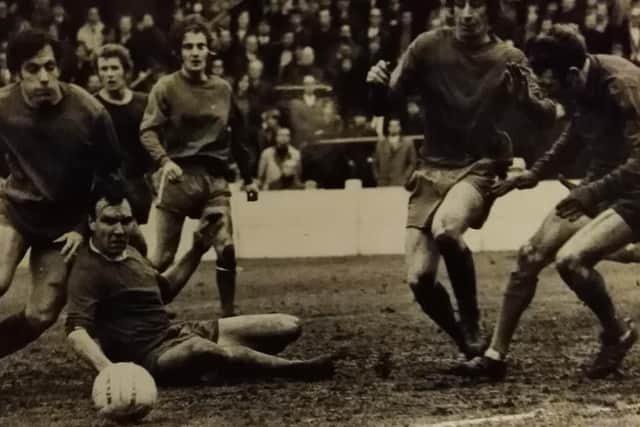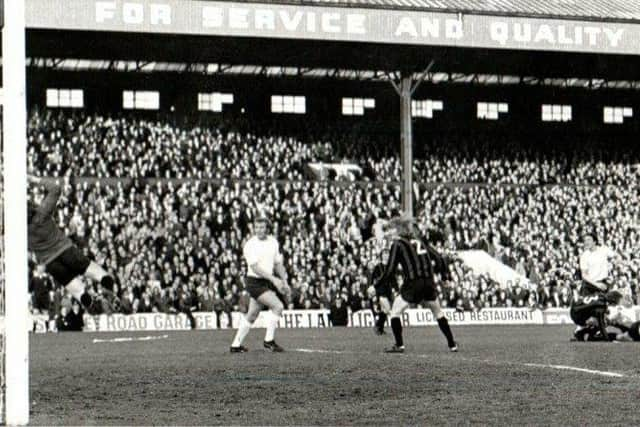How loanee Trevor Womble helped Halifax Town stay up - at the expense of parent club Rotherham


It was a chance virtual conversation I had on social media that led me to delve into the facts behind this week’s subject, that of the curious case of the loan player who assisted Halifax Town but by doing so helped relegate the club from which he belonged to.
Trevor Womble had a great career with Rotherham United, having come through the junior ranks before signing professional forms in October 1968.
Advertisement
Hide AdAdvertisement
Hide AdHe would give the club ten years’ service and be awarded a testimonial in May 1978, having by then made the last of his 214 league appearances for the club.


But during the 1972-73 season he was out of form and out of the side when he agreed to come on loan at Halifax Town to assist George Mulhall’s side, with Millers’ boss Jim McAnearney not unduly worried that this move might come back to haunt him.
After all, two days before Womble agreed to his loan with the Shaymen, Rotherham’s 2-1 victory over Brentford on 6 March had lifted them to 15th in the old Third Division table, though for the most part they had been competing in the top half.
The win left them four points clear of the relegation zone – this was in the days of two points for a win, don’t forget – whilst on the same afternoon, Town’s 1-0 defeat at Charlton Athletic compounded their own misery, leaving them 23 rd , with just Scunthorpe United below them, and 11 points adrift of Rotherham.
Advertisement
Hide AdAdvertisement
Hide AdIt was said of Womble when he arrived that he was a “crowd pleaser who never stops running”, yet his immediate impact at Halifax Town was minimal.


He played his first match with the reserves, a 1-0 success over Lincoln City’s second string, and his involvement with the senior side was as an unused substitute for the home games with Tranmere Rovers and York City, both of which were won by the Shaymen to make their position in the table just slightly more encouraging.
Womble’s first appearance, therefore, was as a 68th minute substitute for John Wilkie in the goalless draw at Grimsby Town as the Shaymen extended their unbeaten run to three matches, though on the same afternoon, Rotherham’s 2-0 defeat of Walsall suggested then that any thoughts of relegation were unfounded.
They were three points clear of 21st-placed Swansea City, with a clutch of clubs between them, whilst Town for their part, were still six points adrift of safety, although their 2-1 victory over Plymouth Argyle, a game in which Womble made his first start, reduced this to four.
Advertisement
Hide AdAdvertisement
Hide AdOn the same day, the Millers lost by the same score at Scunthorpe United, and only then may there have been whispers of relegation talk on the terraces when they prepared to meet Bolton Wanderers on 31 March.
Crucially at this point, Rotherham only had six matches left, whilst the Shaymen were forced to cram in ten before the season’s close.
They had done their survival hopes little good by slipping to midweek defeat at Watford, and on the day that Rotherham secured a surprise 1-0 victory over champions-elect Bolton, Mulhall’s side lost 2-0 at Swansea City.
The positions looked hopeful or despairing for whichever of the two sides you supported; Rotherham or Halifax.
Advertisement
Hide AdAdvertisement
Hide AdThe Shaymen went into their home game with Brentford on 4 April now seven points adrift of safety, but they were perhaps fortunate that the original fixture on 17 February had been postponed due to a frozen pitch.
Then, they had been in a bit of a fix, having won only one of their last 18 matches, a run that had put them in the position they now found themselves.
By the time the match was restaged, form had improved slightly, and so it continued, with Terry Shanahan grabbing all Town’s goals in a 3-2 win, thus becoming the first Town player to score a hat-trick since Les Massie four years earlier.
Victory here left Town looking up at Brentford, who now occupied the first relegation place, four points better off. Walsall in twentieth, had one more point, and Rotherham were one place and one point better off than them.
Advertisement
Hide AdAdvertisement
Hide AdBut Rotherham’s standing would improve with a 1-0 win over Rochdale whilst Town gained a point in a 2-2 draw with Blackburn Rovers at The Shay, the first goal being scored by our man Womble, of whom it had been announced several days earlier that he would remain at the club until the end of the season, the thought not entering the head of Rotherham boss McAnearney that he might recall the player.
Womble’s goal had come as early as the third minute – it was from close range after Fred Kemp’s shot had been deflected – and in an entertaining tussle, the home side regained the lead through Ken Hale before the break only for Tony Parkes to level things early in the second half, chief instigator being former Town player Tony Field.
Rotherham followed up their wins over Bolton and Rochdale with a third, this time a 1-0 success over Southend United on the same evening that Town were going to-to-toe with sixth-placed Oldham Athletic at Boundary Park.
The games were getting tougher for Mulhall’s men and there really was no margin for error, but here they really should have won against a side eyeing promotion.
Advertisement
Hide AdAdvertisement
Hide AdWilkie’s 25th minute goal cancelled out Micky Lester’s strike three minutes earlier, only for Jeff Lee to miss a penalty and Alan Waddle and Womble seeing efforts come back off the underside of the bar.
Still, under the circumstances, a point was valuable but Town’s position still worrying.
They had five games to play, Rotherham had three, but anyone looking at the League table then would have assumed that it was the Millers who were safe.
They were now up to 14th on 41 points, Town eight points worse off than them and five points adrift of safety, a situation that hardly improved when they crashed 3-0 at Bolton on 16 April, a mid-week fixture.
Advertisement
Hide AdAdvertisement
Hide AdIt was always said in those days that the Easter fixtures could make or break a season.
Unthinkable these days, but then it was the norm as clubs usually crammed in three games in the space of four days.
For Rotherham, things did not go well, losing 2-1 at Blackburn on Good Friday, then three days later slipping to a 3-2 home defeat at the hands of Oldham.
In between, Halifax Town entertained Charlton Athletic, but who would have thought as the teams kicked-off that they were about to pull off an act of escapology as good as anything that Harry Houdini had performed?
Advertisement
Hide AdAdvertisement
Hide AdMulhall instilled some belief into his players, and the side belied its lowly status, cruising to a 3-0 win, a scoreline which could and should have been more.
But three goals and two points would do as they inched ever closer to safety, though still four points behind the 20th placed club, which was now York City, whose one remaining game was, as fate would have it, away at Rotherham, who, despite their defeat by Oldham, looked safe in 18th.
Their showdown with York City now took on greater significance following Town’s Easter Tuesday victory over Southend United, a game in which Womble had unwittingly hammered another nail into his own club’s coffin by scoring Town’s first goal after 39 minutes, receiving Waddle’s ball in from the right, making his own space, then lashing home from eight yards.
It was a goal his own manager would have been delighted to see – but only if it had been for Rotherham.
Advertisement
Hide AdAdvertisement
Hide AdShanahan added a second a minute before half-time to give his side a cushion they were grateful for as the visitors took control after the break.
They pulled one back eight minutes from time, but Town, nervously, held on, and suddenly the great escape seemed possible.
Rotherham went into the last game with York City on the final Saturday of the season with all at stake for both clubs.
The Millers knew a point would secure their safety, whilst the Minstermen needed a victory, nothing less, to ensure their own.
Advertisement
Hide AdAdvertisement
Hide AdOn the same afternoon, Halifax Town were set to play their penultimate fixture, a home match with Bournemouth, a side which included in their ranks well-known names in Jimmy Gabriel, Harry Redknapp and former Shay favourite Dave Chadwick.
They also boasted up and coming players in strikers Phil Boyer and Howard Goddard, so they were certainly no pushovers.
With the precariousness of Rotherham’s situation, Trevor Womble was pulled from the action – Jim McAnearney must have felt he’d done enough damage – so there was a recall for full-back Andy Burgin, who’d missed Town’s last four matches, and a midfield berth for Johnny Quinn, who, by the end of the afternoon, could hardly count himself blameless in the demise of his former club.
Quinn himself had been a Rotherham United legend, and how the fans had bemoaned his departure in the close season.
Advertisement
Hide AdAdvertisement
Hide AdHe elected to join the Shaymen, but waited until this game to score his first goal for his new club, Town’s second – it was a shot from the edge of the box which keeper Kieron Baker couldn’t hold in the 52nd minute – which sealed a 2-0 win after a Ken Hale penalty had put them one-up after 39 minutes.
All-in-all, it was quite a comfortable afternoon and the win was most welcome – Town had done all that was asked of them in front of their own fans – but it now proved more than significant when news filtered through that York had beaten Rotherham 2-1 at Millmoor to pull clear of relegation.
With Rotherham now within reach, all Town had to do was win their final match at Walsall and their own safety would be assured.
Mulhall had earlier likened his team’s end of season run-in to the Grand National, rather apt, really, considering that Red Rum had won that year’s event by overhauling Crisp in the final strides of the race, having been way behind at the Elbow.
Advertisement
Hide AdAdvertisement
Hide AdCould one last effort by Town see them scrambling over Rotherham?
Three days after beating Bournemouth, a Tuesday evening, all roads led to Fellows Park for their do-or-die match.
But they would have to do something the side had not done for over two years if they were to survive, win a fourth consecutive match.
Against the odds, and backed by a large Town contingent, the Shaymen won a tense match 1-0 courtesy of a goal scored in the 35th minute by the lanky Alan Waddle, who rose above Walsall’s 19-year-old amateur keeper Jimmy Inger to head home Quinn’s hanging ball from the left.
Advertisement
Hide AdAdvertisement
Hide AdTown saw out the game – keeper Alex Smith brought of a death-defying save late on – and claimed the two most precious of points that saw them draw level with Rotherham.
But in those days, when teams were level on points, it was goal average – goals scored divided by goals conceded – rather than goal difference which decided placings and here Town’s goal average of 0.81 compared to the Millers’ 0.78 was, like a finger of Fudge, just enough, and it was Rotherham who went down.
Alan Waddle was a hero of heroes that night, though his goal was his last significant contribution to Halifax Town’s cause, for having been tracked down in the summer to a hotel just outside Scarborough where he was earning a supplementary wage, he made a record £40,000 move to newly crowned League champions Liverpool, having being scouted by manager Bill Shankly as a possible replacement for John Toshack, who seemed set to join Leicester City.
One player doesn’t make a team, but he can certainly make a difference. Following Womble’s arrival, Halifax Town’s form was on a par with a side challenging at the top end.
Advertisement
Hide AdAdvertisement
Hide AdOnly three games were lost from the final 14 following his arrival, and whatever he brought to the table, Halifax Town certainly benefitted, not least from the two goals he scored.
Job done, Womble duly returned to a sombre Millmoor, with manager Jim McAnearney losing his job following his side’s relegation and being replaced by Jim McGuigan.
But things worked out well, in the end.
Womble featured heavily over the course of the next two seasons, missing only two matches and contributing 14 goals, only one behind top scorer Richard Finney, in 1974-75 as Rotherham clinched promotion back to the Third Division.
But injuries took their toll – he suffered with knee ligament damage – and forced to retire he moved into the catering trade.
Advertisement
Hide AdAdvertisement
Hide AdThree years after their miraculous escape, Halifax Town would be relegated themselves in a season in which Johnny Quinn, who had succeeded Mulhall as manager in September 1974, would be sacked controversially in February 1976 as the side slid down the table.
He was replaced by Alan Ball, who had led Town to their first promotion in 1969, but he had no magic formula, and the Shaymen descended from the third tier of English football, one from which they would never return.
Comment Guidelines
National World encourages reader discussion on our stories. User feedback, insights and back-and-forth exchanges add a rich layer of context to reporting. Please review our Community Guidelines before commenting.